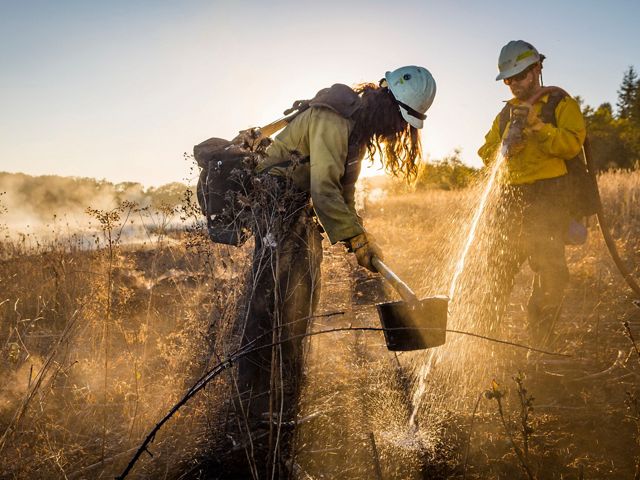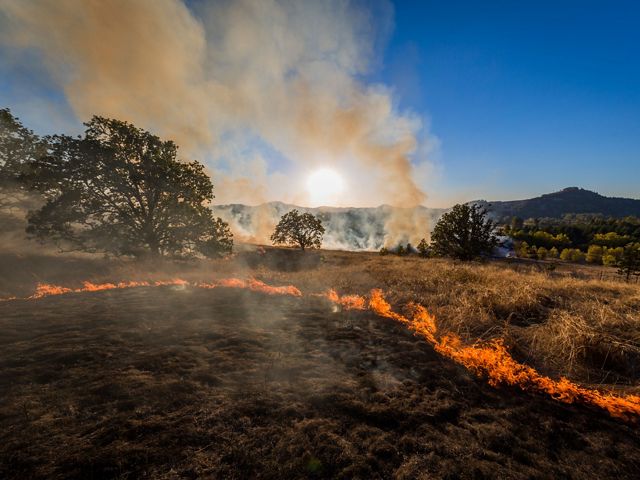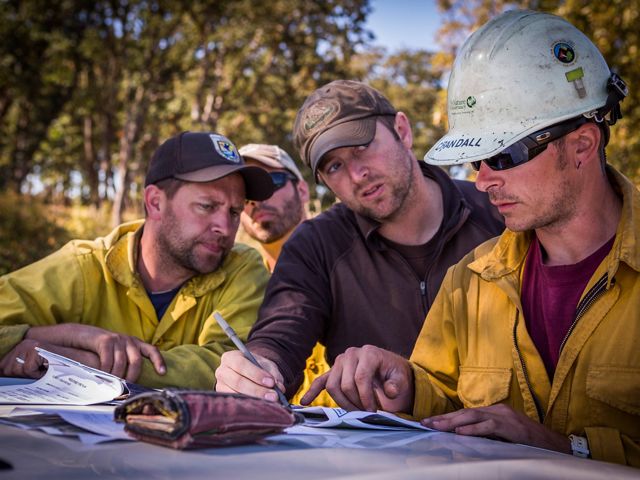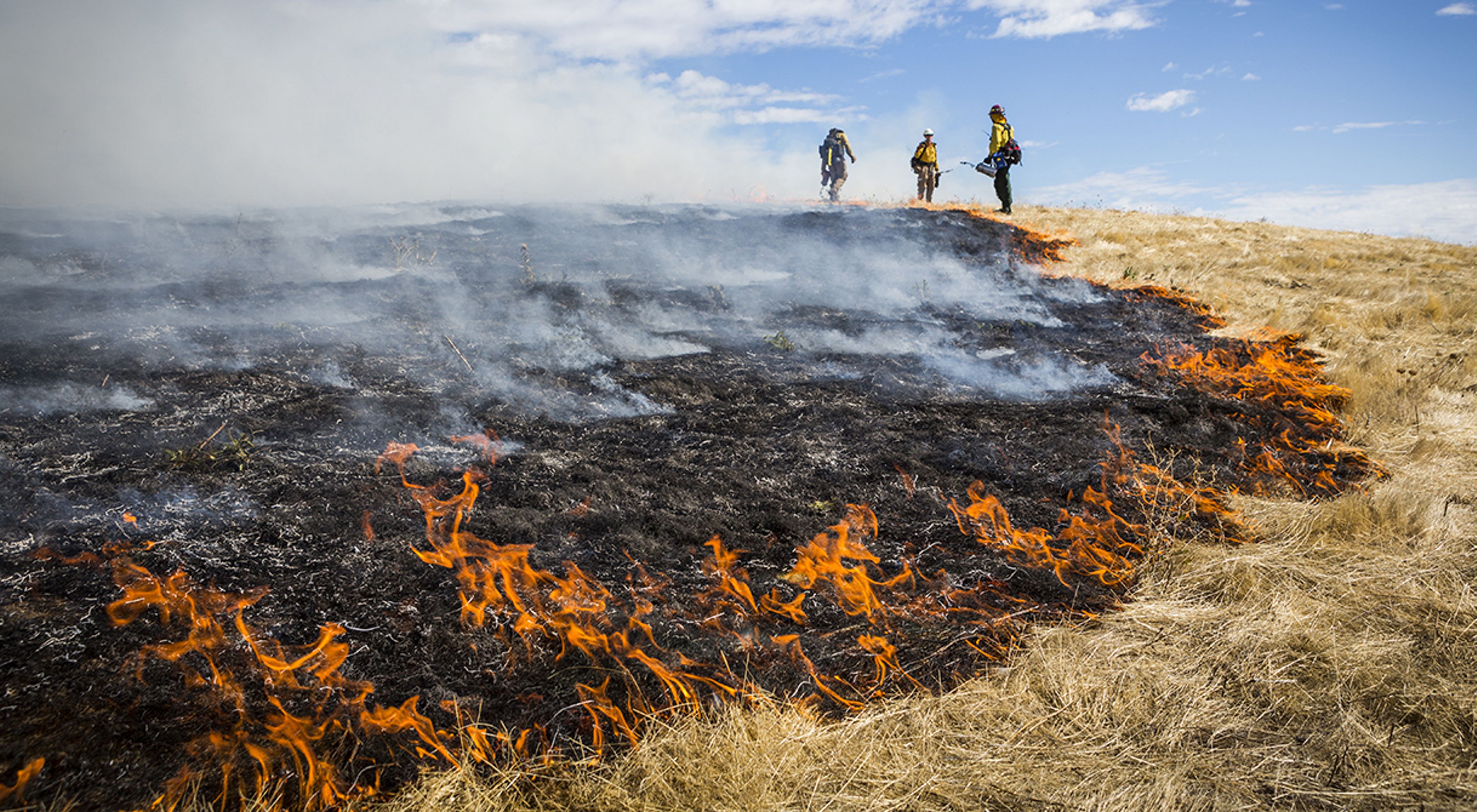Keepers of the Flame
From lighting controlled burns to fighting megafires, the Conservancy’s elite crew is working to restore fire to its natural place across the West.
August/September 2016
On a September morning in Oregon's Willamette Valley, flames were running through waist-high dry grasses, releasing thick waves of smoke across a section of the Willow Creek Preserve, near Eugene. The fire was scorching some of the last protected remnants of native prairie and oak savannas in the southern valley, and firefighters were hustling just to keep up with the fast-moving and intensely hot flames.
“It’s a dynamic environment, and the dead grasses are fine, flashy fuels all driven by wind,” says Jeff Crandall, leader of The Nature Conservancy’s Southern Rockies Wildland Fire Module, a traveling crew of specially trained experts. “Your reaction time is very limited.”
As northerly winds whipped and pushed the flames, the scene may have appeared on the brink of disaster to a casual observer, but Crandall and his six comrades were unfazed. In fact, Crandall says later, watching the fire run its course was “a huge sigh of relief.”
That’s because this was a prescribed burn, purposely ignited after weeks of planning. By clearing away invasive weeds and encroaching ash trees and shrubs that crowd out native grasses, the 16-acre controlled fire helped restore the region’s wet prairie, upland prairie and oak savanna.
Across the West, a century of vigilant fire suppression has left many forests and prairies dangerously overgrown and degraded, prone to catastrophic wildfires that destroy homes and habitat. Members of the Southern Rockies fire crew spend their share of time wrangling wildfires. But they are also applying a science-based strategy to reintroduce and manage fire on the landscapes that naturally need it.
There are just a dozen or so certified Type 1 Wildland Fire Modules across the country, highly trained groups of firefighters prepared to dispatch quickly to remote terrain, equipped with enough gear and food for at least two weeks. Most are run by the National Park Service or Forest Service. The Conservancy’s module is unique for being nongovernmental, and it is dedicated to not only fighting fires but also lighting them. Its members are trained to use prescribed burns—blazes ignited under carefully controlled conditions—and to manage, rather than just suppress, naturally occurring fires as part of a healthy ecosystem.
Since its creation in 2008, this Colorado-based crew has carried out about 60 prescribed burns on some 16,000 acres, and trained hundreds to tackle similar work.

Starting in the 1960S, federal fire managers began reassessing the long-held policy of all-out fire suppression in national parks, forests and grasslands as it became increasingly obvious that the absence of periodic natural fires had altered landscapes and left ecosystems vulnerable. A surplus of fallen branches, small shrubs and debris on the forest floor makes ideal fuel for the worst kinds of wildfires: fast-moving blazes that burn so hot they prohibit natural forest regeneration. In Yellowstone, for instance, lodgepole pines need the regenerative presence of fire, since their resinous cones require high heat to release seeds—but overly intense fires can destroy the cones completely.
Along Colorado’s Front Range, where rapid growth has brought thousands of new homes into forests along the edges of suburbs and cities—a zone known as the wildland-urban interface—extreme wildfires can be deeply damaging to both the landscape and surrounding human communities. That was the case after a very dry winter in Colorado in 2012, when the 87,000-acre High Park Fire destroyed 259 homes and killed one person outside Fort Collins, and the Waldo Canyon Fire, near Colorado Springs, destroyed 346 homes, killed two people and forced the evacuation of 32,000. Soot, ash and landslides from both blazes contaminated local drinking water supplies and rivers. Colorado State University researchers expect that hundreds of thousands more houses will be built in the wildland-urban interface in just the next few decades, meaning many more homeowners—and firefighters—will face heightened risks from wildfires.
The concept of small, specialized wildland firefighting modules emerged in the mid-1990s as wildfires began to increase in scope and intensity across the West. Megafires. those larger than 100,000 acres, used to be a once-a-year exception; now an average of 10 megafires scorch Western forests each year.
The Southern Rockies module was born in 2008, after the Conservancy’s Colorado chapter asked federal and state agencies how the organization could help restore fire to landscapes in a healthy way. The response: establish a wildland fire module that could work alongside federal, state and local agencies on wildfires and also focus on managing naturally occurring fires for ecological benefits. It was “a way for us to directly influence fire management strategies and have an impact on a lot of acres,” says Paige Lewis, former director of Colorado’s Forest Restoration and Fire Program and now its deputy state director and director of conservation programs.
Many members of the Southern Rockies Wildland Fire Module have years of experience on elite federal wildfire crews—called hotshots—and other firefighting units, but they still must log hundreds of hours of training for this job, including backcountry operations, portable weather station monitoring and even mapmaking. They can ignite and direct a controlled burn, clear and oversee a backcountry helispot, or supervise an entire wildfire response if needed.
Working for the Conservancy also means tackling projects that aren’t always directly related to fire: For instance, the crew has built rock structures and curves in rivers to restore grouse habitat. The module also carries out prescribed burns to specifically benefit imperiled species, such as the mountain plover and Colorado butterfly plant in Colorado and the Fender’s blue butterfly and streaked horned lark in Oregon, natural channels and cleared vegetation to improve sage grouse habitat. The module also carries out prescribed burns to specifically benefit imperiled species, such as the mountain plover and Colorado butterfly plant in Colorado and the Fender’s blue butterfly and streaked horned lark in Oregon.

At Willow Creek, the crew opened the day by reviewing the burn plan, weather conditions and safety precautions with its local partners. Next, assistant module leader Thomas Edwards supervised a test burn in a downwind area to ensure that the fire would behave as expected and meet ecological objectives. Four people wielding drip torches flanked the intended burn area to ignite the grasses. A dozen others patrolled the containment lines with two engine trucks spraying water, creating a compacted “wet line” to hold the fire within its planned boundaries.
After weeks of planning, the operation lasted just a few hours. Members then monitored and mopped up the burned area to extinguish any lingering flames before calling it a day.
“On wildfires, it’s go, go, go, go and you’re reacting a lot of the time because the fire is dictating a lot of your actions,” says Crandall, the burn boss that day. “Prescribed fire is where you learn.”
The Willow Creek prescribed fire was one of nearly a dozen that the Conservancy helped conduct in Oregon in a single three-week period in 2015, collaborating with the U.S. Fish and Wildlife Service and other agencies. The projects replicated blazes once ignited by Native Americans to protect and restore the fire-dependent wet prairies and oak savannas, now down to just a fraction of their former range in the Pacific Northwest.
“Fire is the most economical and effective tool we have for maintaining the open character of the wet prairie, upland prairie and oak savannas and even woodlands,” says Amanda Stamper, fire management officer for the Conservancy’s Oregon chapter and a certified burn boss.
Closer to home, the Conservancy’s module has also used prescribed fire in recent years to manage invasive cheatgrass and help control encroaching conifers at several Colorado grassland sites. It has created and carried out restoration plans on many forest parcels and conducted pre- and postburn monitoring, tree thinning and brush clearing to set the stage for prescribed burns.
The Conservancy offers “a science-based and positive voice around the need to return fire to these ecosystems in a safe and effective way to avoid the unnaturally large and damaging wildfires that we’re seeing,” says Lewis. That’s especially important for local fire response partners that lack the resources to develop and implement their own prescribed burn plans.
“We’re trying to be a catalyst for change that drives our partners at local, state and federal levels to use a wider range of science-based management tools and incorporate both natural and prescribed fire more frequently,” Lewis says, “so that we can treat more acres and have a larger-scale impact in these high-risk forests and watersheds.”

Usually by mid-June, the module must shift its efforts from conservation-centered projects to fighting wildfires. Last year marked the nation’s most expansive and expensive fire season yet. Wildfires scorched more than 10.1 million acres nationally in 2015, destroying about 4,500 homes and killing 13 wildland firefighters. Fire suppression and related costs totaled $2.6 billion; the Forest Service spent more than half of its entire 2015 budget on fire management, diverting funds from forest health projects. The acreage and costs both set records, stoked by the second worst fire season ever in Alaska, which accounted for 768 wildfires affecting 5.1 million acres.
In late June 2015, the National Interagency Coordination Center dispatched the Southern Rockies module to the isolated village of Hughes, Alaska, population 77. Two hundred miles northwest of Fairbanks and accessible only by boat or plane, the Isahultila and Rock fires were both closing in on Hughes, scorching spruce-dominated boreal forests along the way and burning thick layers of soil, organic material called duff and permafrost that release huge amounts of carbon into the atmosphere.
For three weeks, in perpetual sunlight and swarms of mosquitoes and gnats, the Conservancy’s firefighters slogged away, working 16-hour days with other crews to protect the town and control the paths of the blazes. With the fires crackling through the spruce a few miles away, members cleared trees along the borders of the village and then set up roughly 7 miles of hoses and sprinklers surrounding the entire community to ward off flames that might creep toward houses and fishing shacks. The landscape—soggy, wobbly permafrost and mounds of tussock grass—added to the challenge of carrying 60 or so pounds of hose and other gear. A few times, members hit a partially melted patch of ground and sank waist deep into the tundra.
As the Rock Fire moved closer to the village, the Southern Rockies crew and others planned a massive burnout to consume any fuel in the path of the approaching wildfire. They spent two days cutting and clearing a three-mile-long fire line along a ridge, then deployed drip torches to unleash a wave of heat, flames and smoke through the tundra and forest canopy. The fire did its job, consuming an estimated 30,000 to 40,000 acres—much larger than a typical burnout in the Lower 48—while crews mopped up smoldering stumps and ash pits “in the black” and watched out for spot fires.
The village was safe. The job was done, but many more awaited. After two mandated days off back in Colorado, the firefighters were called out to a blaze in Idaho for two weeks. A few more days of required rest, and then off to Montana. Looking back, Crandall says the summer’s frantic pace was unsurprising. “It’s fire season. That’s why we’re here.”
